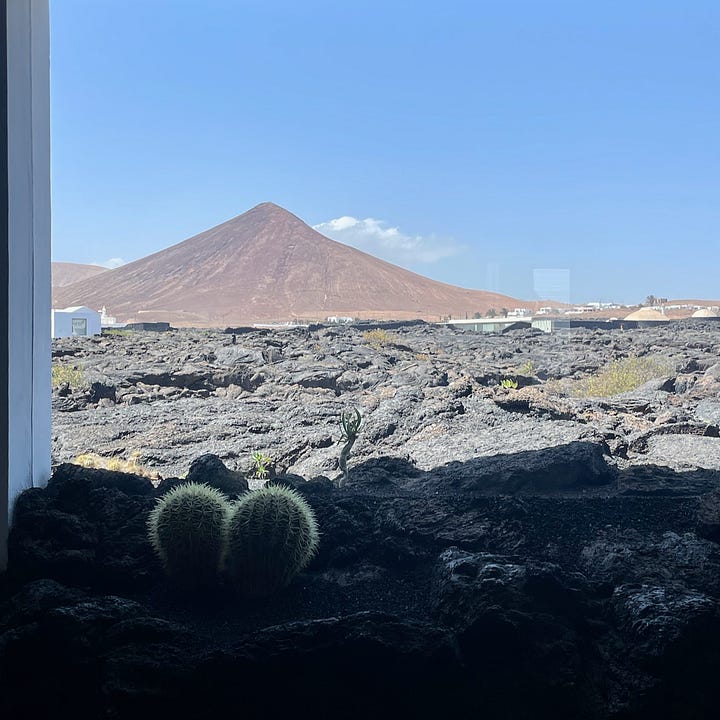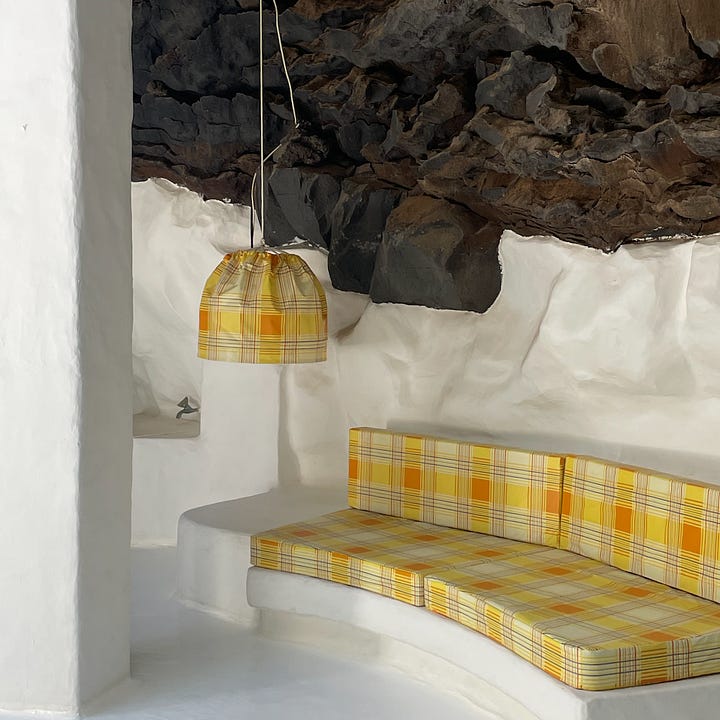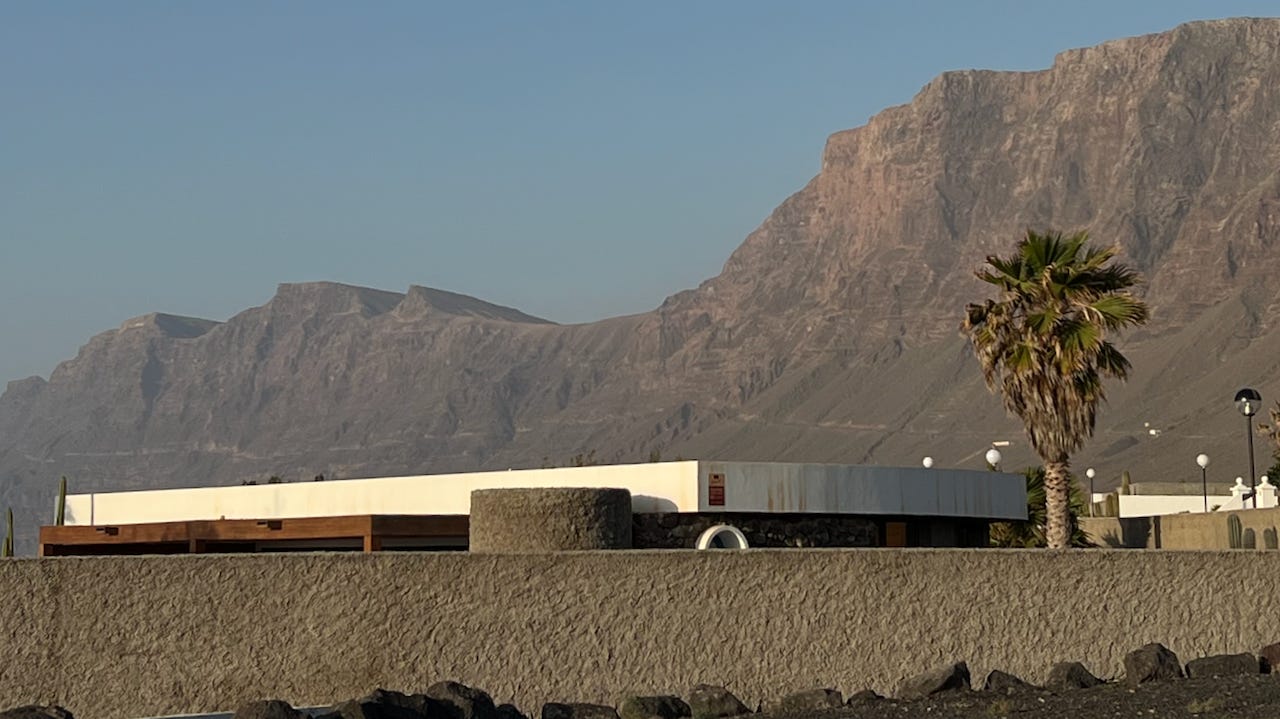Happy Easter everyone! At the beginning of the month we got back from a few days on this dramatic volcanic island. Before taking the trip our destination seemed to provoke mixed reactions from friends, mainly British, who were concerned we were going to a resort mildly resembling the one Kate, Laurie and Jaclyn go to ‘escape’ the White Lotus (you will get this reference unless you have been hiding under a rock this past month). But in fact what we knew was drawing us to this island was a rich culture, dramatic landscape, volcanic wines, and sunshine!
We had a beautiful time there, so here’s a brief guide sharing our tips.
GETTING AROUND
No two ways around it: rent a car. The local Canary Island company CIcar has very decent prices and we found them super user-friendly. A welcome change from usual car rentals.
STAY


Built between 1969 and 1973 by architect Miguel Martin-Fernandez de la Torre, in collaboration with Norwegian architect Per Ørnulf Øien, the bungalows sit almost directly on one of the island’s best surf beaches. Try to book one of the older bungalows that still features original furniture—what our friend Paul perfectly described as “Flintstone furniture” (think clunky and wooden - call them Brutalist style and these bad boys would sell for nothing less than £1k at a vintage market in London). The website feels straight out of the ’90s, and the service is German and efficient—all part of the charm.
The village of Famara is on the North-Western side of the island, and turned out to be the favourite nook and holiday getaway of many locals on this small island. A good sign.
This time we were after something self-catering, but when we return to the island we want to try Buenavista B&B, which came recommended by both friends and locals.
EAT


Casa Juan Ramón - simple, authentic, no frills tapas restaurant but super delicious. Ideal for lunch after arriving from the airport. Portions are generous, which quite frankly we are unaccustomed to after years of dining in London “small plates” restaurants who offer you four garlic gambas for the cost of a flight to Málaga. All this to say, we over-ordered and left with very full bellies.
Restaurant El Barquillo - For the freshest seafood that they also supply to some of the more high-end restaurants on the island; and clearly where all the locals go for their own Sunday lunch, evident from the small queue outside their door.
SeBe and Munsoo - Came recommended by our beautiful new friends Laura and Eammon (more on them later).
Centro Cultural La Tegala - Most delicious mojo verde (green sauce originating from the Canary Islands) that we scooped up with fresh bread rolls. So much garlic that we felt grateful we were only kissing each other.
Restaurant El Charcon - Managed by the charismatic owner who called me Esmerelda and gave us some small cervezas while we waited a short while for our table. This is a great stop if you are visiting the nearby Jameos del Agua by Manrique.
Dunas - Restaurant in the complex of the bungalows. Definitely convenient if staying nearby but portions feel a bit more in the direction of London standards. Order the paella to share!
DO


The island may be small, but there’s a lot on offer. In five days we were able to pack in culture, sports, wine tasting and, let’s be honest, a good dose of loafing.
Culture
César Manrique (1920-1992) is the artist figure towering above Lanzarote. He was a visionary artist whose unique blend of nature and art transformed the landscapes of his island into breathtaking works. He was also a strong advocate for local sustainability and cultural identity. His houses are a definite must-see.
First is Volcano House - his first home is built in a lava field (the last volcanic eruption on the island was as late as the 18th Century) and literally carved in natural interconnected lava grottoes. The house is a total 60s vibe, complete with outdoor lounge furniture and fun pool to entertain the jet set of the time. It is now home to the César Manrique Foundation.
His second home and studio in Haría is built in a more recluse part of the island where he lived until his death. It transforms a derelict farmhouse in beautiful tones of white and wood, with mirror-clad bathrooms and abundant daylight. He designed a third house, which we didn’t get the chance to see this time, called LagOmar with architect Jesús Soto.


If you’re into it, we’d also recommend visiting his other creations, notably the stunning Jameos del Agua and Jardín de Cactus. The Mirador del Río is a viewpoint on the north of the island; the organic shapes carved in the rock were almost reminiscent of Casa Organica in Mexico.
Make sure to drive through the volcanic Timanfaya National Park, for its lunar landscape. The restaurant El Diablo is perched on top of a volcano and cooks with the geothermal energy.
Wine


Lanzarote is big on wine, as not much else than vine grows on the volcanic landscape.
Most of the winemaking is traditional, but we found some brilliant natural / biodynamic winemakers. If you visit only one vineyard, make it Bodega Cohombrillo. It was our first stop after landing, and it felt magical—as they were preparing to bottle that year’s harvest, we had the chance to taste wines straight from the tank. Laura and Eamonn craft the most beautiful wines, rich with layers of minerality that reflect the complexity of the soil where their vines grow. And beyond that, they’re simply wonderful people. So much so that they graciously welcomed us three times during our five-day trip! We chatted about family, business, house renovations, and dreams over glasses of wine, while hearing the story of the vineyard passed down from Eamonn’s father, while both coming from winemaking families. Muchas muchas gracias, Laura y Eamonn!
We also had the pleasure of getting a tour through the vineyards of Titerok-Akaet with Anna, who has been working for the small-scale vineyard for the past couple of years and is a winemaker herself - another delicious option for wine tasting.
Sports
Finally, there’s plenty to keep active with. Famara is a famous surfing spot, we did some proper hiking up the volcanic mountains and the island is a well-known spot for serious bike/running training with good weather year-round.
We hope you enjoy; let us know your own favourite spots and we can share as well.





